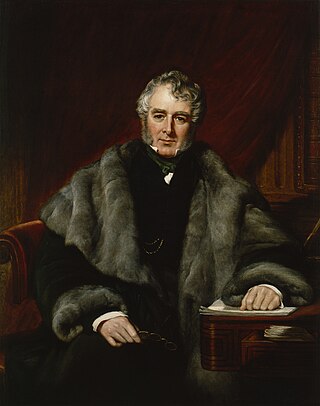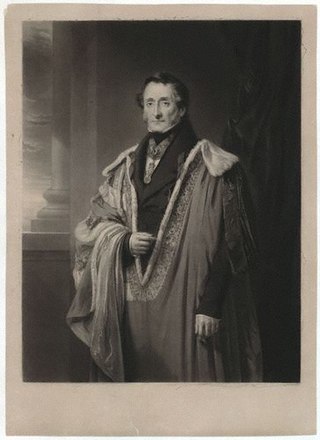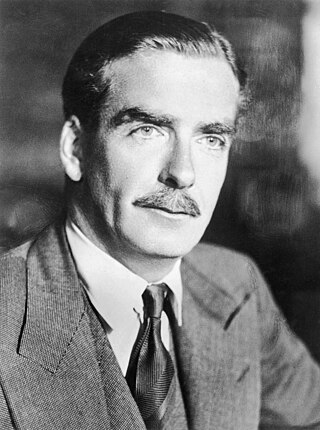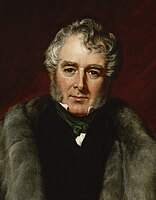
George Hamilton-Gordon, 4th Earl of Aberdeen,, styled Lord Haddo from 1791 to 1801, was a British statesman, diplomat and landowner, successively a Tory, Conservative and Peelite politician and specialist in foreign affairs. He served as Prime Minister from 1852 until 1855 in a coalition between the Whigs and Peelites, with Radical and Irish support. The Aberdeen ministry was filled with powerful and talented politicians, whom Aberdeen was largely unable to control and direct. Despite his trying to avoid this happening, it took Britain into the Crimean War, and fell when its conduct became unpopular, after which Aberdeen retired from politics.

William Lamb, 2nd Viscount Melbourne was a British Whig politician who served as the Home Secretary and twice as the Prime Minister of the United Kingdom. Some sources indicate that his full name was Henry William Lamb.

Sir Robert Peel, 2nd Baronet,, was a British Conservative statesman who served twice as Prime Minister of the United Kingdom, simultaneously serving as Chancellor of the Exchequer (1834–1835). He previously served twice as Home Secretary. He is regarded as the father of modern British policing, owing to his founding of the Metropolitan Police Service while he was Home Secretary. Peel was one of the founders of the modern Conservative Party.

John Russell, 1st Earl Russell,, known by his courtesy title Lord John Russell before 1861, was a British Whig and Liberal statesman who served as Prime Minister of the United Kingdom from 1846 to 1852 and again from 1865 to 1866.

The Lord Privy Seal is the fifth of the Great Officers of State in the United Kingdom, ranking beneath the Lord President of the Council and above the Lord Great Chamberlain. Originally, its holder was responsible for the monarch's personal (privy) seal until the use of such a seal became obsolete. Though one of the oldest offices in European governments, it has no particular function today because the use of a privy seal has been obsolete for centuries; it may be regarded as a traditional sinecure, but today, the holder of the office is invariably given a seat in the Cabinet of the United Kingdom, and is sometimes referred to as a minister without portfolio.

Charles Manners-Sutton, 1st Viscount Canterbury, was a British Tory politician who served as Speaker of the House of Commons from 1817 to 1835.

James Abercromby, 1st Baron Dunfermline FRSE, was a British barrister and Whig politician. He served as Speaker of the House of Commons between 1835 and 1839, the first Scottish MP to hold that position.

Gathorne Gathorne-Hardy, 1st Earl of Cranbrook, was a prominent British Conservative politician. He held cabinet office in every Conservative government between 1858 and 1892. He served as Home Secretary from 1867 to 1868, Secretary of State for War from 1874 to 1878, Lord President of the Council from 1885 to 1886 and as Chancellor of the Duchy of Lancaster until 1886. In 1878, he was appointed Secretary of State for India and thereafter was elevated to the peerage, entering the House of Lords as Viscount Cranbrook. He has been described as a moderate, middle-of-the-road Anglican, and a key ally of Disraeli.

In the 1841 United Kingdom general election, there was a big swing as Sir Robert Peel's Conservatives took control of the House of Commons. Melbourne's Whigs had seen their support in the Commons erode over the previous years. Whilst Melbourne enjoyed the firm support of the young Queen Victoria, his ministry had seen increasing defeats in the Commons, culminating in the defeat of the government's budget in May 1841 by 36 votes, and by 1 vote in a 4 June 1841 vote of no confidence put forward by Peel. According to precedent, Melbourne's defeat required his resignation. However, the cabinet decided to ask for a dissolution, which was opposed by Melbourne personally, but he came to accept the wishes of the ministers. Melbourne requested the Queen dissolve Parliament, leading to an election. The Queen thus prorogued Parliament on 22 June.

John William Ponsonby, 4th Earl of Bessborough, PC, known as Viscount Duncannon from 1793 to 1844, was a British Whig politician. He was notably Home Secretary in 1834 and served as Lord Lieutenant of Ireland between 1846 and 1847, the first years of the Great Famine.

Earl of Bessborough is a title in the Peerage of Ireland. It was created in 1739 for Brabazon Ponsonby, 2nd Viscount Duncannon, who had previously represented Newtownards and County Kildare in the Irish House of Commons. In 1749, he was given the additional title of Baron Ponsonby of Sysonby, in the County of Leicester, in the Peerage of Great Britain, which entitled him to a seat in the British House of Lords. The titles Viscount Duncannon, of the fort of Duncannon in the County of Wexford, and Baron Bessborough, of Bessborough, Piltown, in the County of Kilkenny, had been created in the Peerage of Ireland in 1723 and 1721 respectively for Lord Bessborough's father William Ponsonby, who had earlier represented County Kilkenny in the Irish House of Commons.

Henry George Grey, 3rd Earl Grey, known as Viscount Howick from 1807 until 1845, was an English statesman and cabinet minister in the government of the United Kingdom.

Francis Thornhill Baring, 1st Baron Northbrook,, known as Sir Francis Baring, 3rd Baronet, from 1848 to 1866, was a British Whig politician who served in the governments of Lord Melbourne and Lord John Russell.

Thomas Hamilton, 9th Earl of Haddington, KT, PC, FRS, FRSE, known as Lord Binning from 1794 to 1828, was a Scottish Conservative statesman.

Henry Labouchere, 1st Baron Taunton, PC was a prominent British Whig and Liberal Party politician of the mid-19th century.

The second Peel ministry was formed by Sir Robert Peel in the United Kingdom of Great Britain and Ireland in 1841.

Ernest Augustus Charles Brudenell-Bruce, 3rd Marquess of Ailesbury PC, styled Lord Ernest Bruce from 1821 until 1878, was a British courtier and politician. He served as Vice-Chamberlain of the Household between 1841 and 1846 and again between 1852 and 1858. An MP for 46 years, he succeeded his elder brother in the marquessate in 1878.

The Bedchamber crisis occurred on 7 May 1839 after Whig politician William Lamb, 2nd Viscount Melbourne declared his intention to resign as Prime Minister of the United Kingdom after a government bill passed by a very narrow margin of only five votes in the House of Commons. Following a few false moves toward an alternative Tory prime minister and a Conservative government, Lord Melbourne was reinstated until the 1841 election, when the Conservative party took over.

The Eden ministry was formed following the resignation of Winston Churchill in April 1955. Anthony Eden, then-Deputy Prime Minister and Foreign Secretary, took over as Leader of the Conservative Party, and thus became Prime Minister of the United Kingdom. Upon assuming office, Eden asked Queen Elizabeth II to dissolve parliament and called a general election for May 1955. After winning the general election with a majority of 60 seats in the House of Commons, Eden governed until his resignation on 10 January 1957.



















